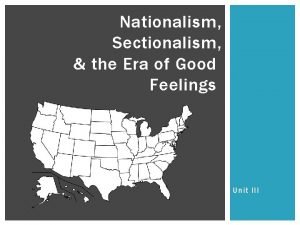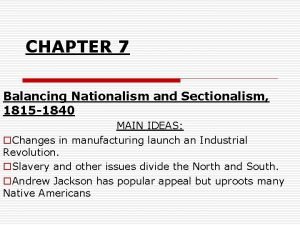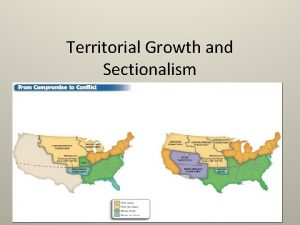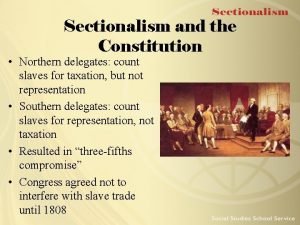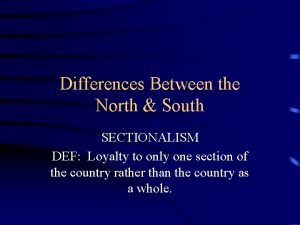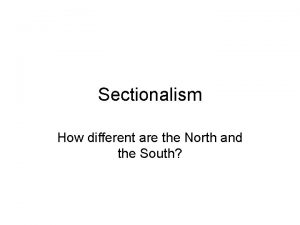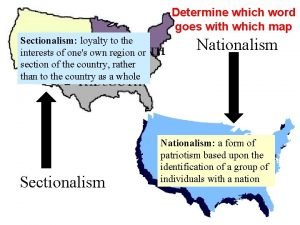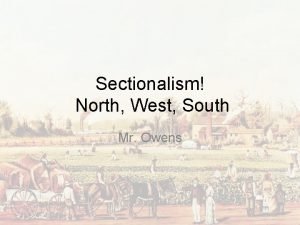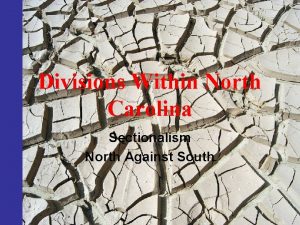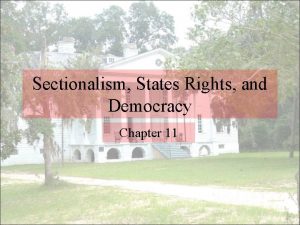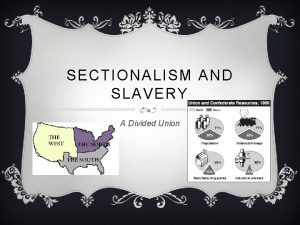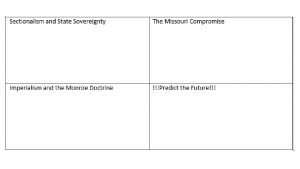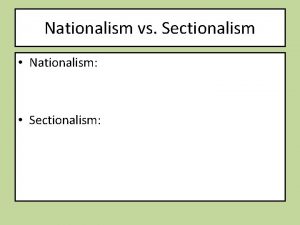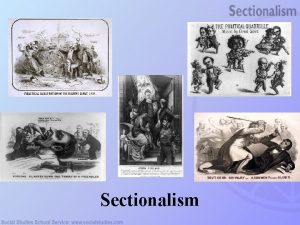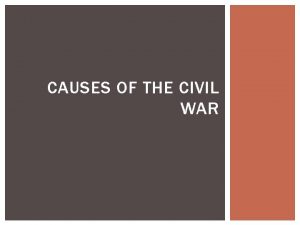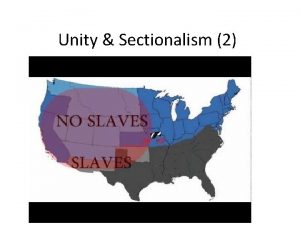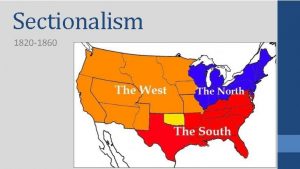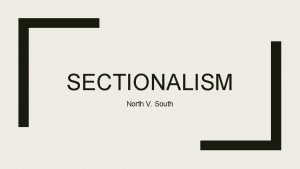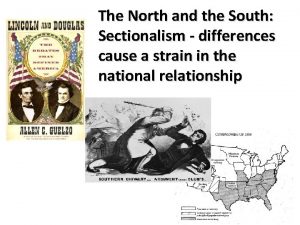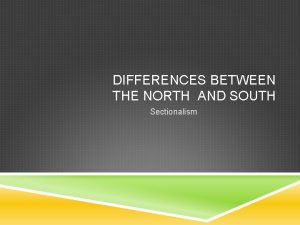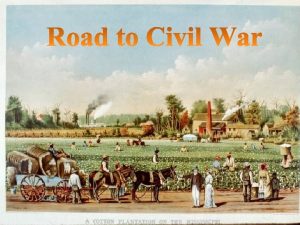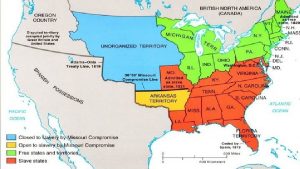Sectionalism How different are the North and the













































- Slides: 45

Sectionalism How different are the North and the South?

• Sectionalism is loyalty to the interests of one's own region or section of the country, rather than the nation as a whole. • It is an exaggerated devotion to the interests of a region

• So, what unites the North as a “section”, and what unites the South as a separate “section”? • How do sectional differences make the North and South want to go to war?

Sectionalism and Economies Can money concerns cause a war?


HOW GEOGRAPHY INFLUENCES THE ECONOMY…. .

Elevation (in Brown)

Which region had more mountains? Which region had broad, flat plaines?

• North – Higher elevations, more changes in elevation • South – Lower elevations, more broad, flat plains

Precipitation (heavier in Green)

Which region received more rainfall?

• North – Milder precipitation • South – More intense precipitation and humidity

Soil Composition – Nutritional value of Soil (in Orange)

Which region had healthier soil?

• North – More rocky soil, more metals and minerals, dryer land • South – More rich and fertile soil, more crop nutrients

Woodlands/Ground Cover (in Green)

Which region had more forests?

Mineral Deposits – Ground Metals (in Purple)

Which region was rich in copper, tin, coal and other natural resources?

• North – More forests and tree cover, more mined metals • South – more open plains

Temperature – (warmer as you approach Red)

Which region had higher average temperatures?

• North – cooler overall climate, more extremes, shorter growing season • South – warmer, milder overall climate, less extremes, longer growing season

CONCLUSION

How did people in the Northern regions earn a living? How did people in the Southern regions earn a living?

THE NORTH • Small farmsteads • Industries like mining and lumber mills • Factories fueled by coal taking raw materials and making finished products such as furniture, steel, glassware, edible food items, tins, ships, etc.

• There were 110, 000 factories in the north as opposed to just 20, 000 in the south • Industrial production in the north averaged over $1. 5 billion a year, as opposed to less than $155 million a year in the south

THE SOUTH • Highly profitable system of laborintensive crops like tobacco and cotton, grown on large working farms called plantations. • These were items that couldn’t be grown in most parts of the world yet where in extremely high demand

But will people go to war simply based on the fact that they have different ways of earning incomes?

Tariffs • Tariffs are protective taxes on imports and exports. Extra money is added to the cost of incoming goods, and often on outgoing goods as well.

The north supported high government tariffs – Taxes on imports would make foreign goods too expensive for the American public to purchase and urge them to buy goods made here – northern profits would increase – Remember, the south was an exclusive market because they didn’t make any of their own finished products – even more profits

The south supported low government tariffs –Since the south imported just about everything, low tariffs would keep costs down by allowing foreign goods to compete with northern goods

The south supported low government tariffs – Since the largest markets for cotton and tobacco were overseas, high tariffs here may either add an extra cost to ship it, or other countries may choose to raise their tariffs. Either way the cost of southern goods went up • Other countries may look elsewhere for cotton (Egypt, India) or tobacco (Cuba, Turkey)

What other regional differences existed between the North and the South?

Population (in Red)

• North – Higher population, more concentrated population, larger cities, larger pool of workers • South – Lower population, more spread out population, less available workers (slave labor needed? )

THE NORTH • Two and half times the population of the South due to the amount of ports of entry into the country for immigrants looking for decent pay and low-skilled factory work. Seven out of every eight immigrants settled in the North rather than the South. • The need for slave labor was low due to the fact that there were enough hands available to do the jobs – slaves were more considered a personal luxury as in -home servants

THE SOUTH • Tobacco and cotton are very labor intensive crops that need year-round cultivation. The south had only 1/3 of the country’s population, and a job requiring the yearround, outside care of difficult plants didn’t attract many northerners, immigrants, or even southerners. The demand for cheap (free) labor was extremely high to make plantations profitable.

Cotton Production

Slave Population

Slave-Owning Population (1850)

Population

• North – More immigrants and those of foreign parentage South – More “Americans” by birth

Religion

• North – More Catholic • South – More Protestant
 Antigentest åre
Antigentest åre What's the difference between nationalism and sectionalism
What's the difference between nationalism and sectionalism Quiz 3 nationalism and sectionalism
Quiz 3 nationalism and sectionalism Patriotism vs nationalism venn diagram
Patriotism vs nationalism venn diagram Era of good feelings nationalism
Era of good feelings nationalism Chapter 7 balancing nationalism and sectionalism
Chapter 7 balancing nationalism and sectionalism Ics north east
Ics north east Chapter 14 lesson 2 north and south
Chapter 14 lesson 2 north and south Sectionalism map of the united states
Sectionalism map of the united states Nationalism vs sectionalism
Nationalism vs sectionalism West sectionalism
West sectionalism Sectionalism def
Sectionalism def Clay's american system apush
Clay's american system apush Sectionalism def
Sectionalism def Sectionalism def
Sectionalism def Sectionalism map
Sectionalism map Sectionalism
Sectionalism Sectionalism def
Sectionalism def Sectionalism
Sectionalism Sectionalism def
Sectionalism def True north vs magnetic north
True north vs magnetic north The north pole ____ a latitude of 90 degrees north
The north pole ____ a latitude of 90 degrees north Thermosoftening plastics examples
Thermosoftening plastics examples Flame test principle
Flame test principle Sound will travel at different speeds in different mediums.
Sound will travel at different speeds in different mediums. Examples of a medium in waves
Examples of a medium in waves Different culture have different moral codes
Different culture have different moral codes Different angle different story
Different angle different story Acid base song
Acid base song Manufactured boards examples
Manufactured boards examples We are all different but the same
We are all different but the same Argumenterande tal struktur
Argumenterande tal struktur Hình ảnh bộ gõ cơ thể búng tay
Hình ảnh bộ gõ cơ thể búng tay Lp html
Lp html Bổ thể
Bổ thể Tỉ lệ cơ thể trẻ em
Tỉ lệ cơ thể trẻ em Chó sói
Chó sói Tư thế worm breton
Tư thế worm breton Alleluia hat len nguoi oi
Alleluia hat len nguoi oi Môn thể thao bắt đầu bằng chữ đua
Môn thể thao bắt đầu bằng chữ đua Thế nào là hệ số cao nhất
Thế nào là hệ số cao nhất Các châu lục và đại dương trên thế giới
Các châu lục và đại dương trên thế giới Công thức tính độ biến thiên đông lượng
Công thức tính độ biến thiên đông lượng Trời xanh đây là của chúng ta thể thơ
Trời xanh đây là của chúng ta thể thơ Mật thư tọa độ 5x5
Mật thư tọa độ 5x5 Phép trừ bù
Phép trừ bù




